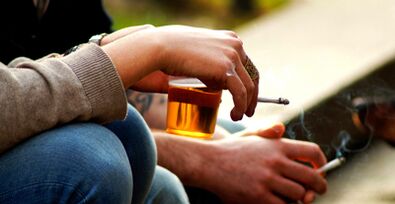According to many experts, chronic prostatitis is an inflammatory disease caused by infection with the possible addition of autoimmune disorders, characterized by damage to the parenchymal and interstitial tissue of the organ.Medicine has known about the disease since 1850, but even today it remains little known and difficult to treat.Chronic bacterial (6 - 10%) and non-bacterial (80 - 90%) prostatitis are the most common and socially significant inflammatory diseases in men, and significantly reduce their quality of life.The disease is recorded mainly in young and middle-aged people and is often complicated by disorders of copulatory and generative functions (decreased potency, infertility, etc.).The disease is recorded in men between 8 and 35% of cases between 20 and 40 years old.
The cause of bacterial prostatitis is the pyogenic flora that penetrates the gland from the urethra or by lymphogenic and hematogenous route.The etiology of chronic non -bacterial prostatitis and its pathogenesis is still unknown.Mainly affects men over 50 years.
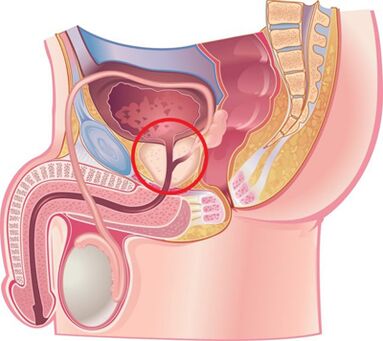
Reasons for the development of the disease
Chronic prostatitis is currently considered a polyietiological disease.There is an opinion that the disease arises as a result of an infection that enters the prostate and then the pathological process continues without its participation.This is facilitated by a series of non -infectious factors.
Infectious factors in the development of chronic prostatitis.
In 90% of cases, pathogens enter the gland from the urethra and cause acute or chronic prostatitis.There have been cases of asymptomatic transport.The course of the disease is influenced by the state of the human body defenses and the biological properties of the pathogen.It is assumed that the transition from acute to chronic prostatitis occurs due to the loss of tissue elasticity due to excess production of fibrous tissue.
Among the causative agents of chronic prostatitis are the following pathogens:
- In 90% of cases, the disease reveals gram -negative bacteria such as Escherichia coli (Escherichia coli), Enterococcus faecalis (fecal enterococcal) and, less frequently, aeruginosa pseudomonas, Klebsiella spp., Proteus spp., Aeruginous pseudomonas, enterobacter aerogenes and acinetobacter spp.Enterorococcal grampic bacteria, streptococci and staphylococci are rare.
- The role of negative coagulase staphylococci, ureaplasma, clamidia, trichomonas, gardnerella, anaerobic bacteria and fungi of the genus Candida has not completely elucidated.
The infection enters the prostate in several ways:
- The ascending path is the most likely, as evidenced by the frequent combination of prostatitis and urethritis.
- Hematogenous prostatitis develops when the infection enters the gland through the bloodstream, which is observed in chronic tonsilitis, sinusitis, periodontitis, pneumonia, cholecystitis and cholangitis, purulent skin diseases, etc.
- Chronic contact with contact prostatitis is developed with urethritis and urethra restrictions, when infection penetrates the gland that ascends with urine current, with purulent infections of the kidneys, channelcular by epipiditics, defentitis and funiculite, during the therapeutic and therapeutic urological manulations (catheterization, swings, swings, instructions, instructions ofUrutic, including traffic.
- Lymphogenic infection penetrates the prostate with proctus, thrombophlebitis of hemorrhoidal veins, etc.

Non -infectious factors in the development of chronic prostatitis
Chemical factors
According to experts, the main role in the development of chronic prostatitis belongs to intraprostatic reflux urine when urine is thrown from the urethra into the iron, which leads to a violation of the emptying of the prostate and seminal vesicles.
With the disease, the vascular reactions develop to the edema of the organ, the nerve and humoral regulation of the tissue tone of the smooth muscle of the urethra, and the activation of the alpha1–The adrenorecceptors causes the development of dynamic obstruction and contributes to the development of new intraprostatic reflux.
Uratos contained in urine, with reflux, lead to the development of a "chemical inflammatory response."
Hemodynamic disorders
Support the chronic inflammation of circulatory disorders in pelvic organs and scrotum.Stagnation is developed in people who lead a sedentary lifestyle, for example, for drivers, office employees, etc., with obesity, sexual withdrawal, sexual dysmetry, frequent hypothermies, mental and physical overloads.Maintain the inflammatory process, taking spicy foods and spicy, alcohol and smoking, etc.
Other factors
There are many other factors that promote chronic inflammation of the prostate.These include:
- hormonal.
- Biochemical.
- Immune response disorders.
- Autoimmune mechanisms.
- Infectious and allergic processes.
- Characteristics of the structure of the prostate that hinder adequate drainage.
Very often, the causes of the development of chronic prostatitis cannot be determined.
Classification of prostatitis
According to the classification proposed in 1995 by the United States National Institutes of Health, prostatitis is divided into:
- Acute (category I).It amounts to 5 - 10%.
- Chronic bacterial (category II).Ascends to 6 - 10%.
- Chronic non -bacterial inflammatory (category IIIA).It is from 80 to 90%.
- Non-bacterial non-inflammatory (category IIIB) or chronic pelvic pain syndrome.
- Chronic prostatitis detected by chance (category IV).
Signs and symptoms of chronic prostatitis.
The course of chronic prostatitis is long, but not monotonous.Periods of exacerbation are followed by periods of relative calm, which occur after complex anti-inflammatory and antibacterial therapy.
The development of chronic bacterial prostatitis is often preceded by urethritis of bacterial or gonorreic nature, non -bacterial circulatory disorders in pelvic and scrotal organs (hemorrhoids, varicocellus, etc.), sexual excesses.
Patients with chronic prostatitis have many complaints.They have been going to the doctor for years, but they rarely examine them to detect prostate diseases.Approximately a quarter of patients has no complaint or the disease occurs with few clinical symptoms.
Complaints of patients with chronic prostatitis can be divided into several groups.
Urinary disorders associated with the narrowing of the urethra:
- Difficulty urinating initially.
- Weak urine jet.
- Intermittent or dribbling urination.
- Sensation of incomplete emptying of the bladder.
Symptoms caused by irritation of nerve endings:
- Frequent urination.
- The need to urinate is acute and strong.
- Urination in small portions.
- Urinary incontinence during the desire to urinate.
Pain syndrome:
- The intensity and nature of the pain are different.
- Location of pain: lower abdomen, perineum area, rectum, groin and lower back, the inner surface of the hips.
Sexual function disorders:
- Pain in the rectum and urethra during ejaculation.
- Slow erection.
- Loss of orgasm.
- Premature ejaculation, etc.
From the nervous system: neurotic disorders in the way of setting the care of patients in the state of their health.
Signs and symptoms of chronic non -bacterial prostatitis
Chronic pelvic pain in men (CFTB) proceeds with the usual symptoms for chronic prostatitis, but in the third part of the urine and a secret of the prostate in the study of bacteria are absent.Simulating CTB can simulate chronic nebacterial interstitial cystitis, rectal diseases, pelvic floor spastic myalgia, and a functional prostate caused by impaired innervation of organic organs and their hemodynamics.
In the case of impaired neurovegetative function, dullness and impaired innervation of the gland are observed, which is manifested by difficulties in rapid and complete closure of the lumen of the urethra.At the same time, urine, after urine, continues to stand out for a long time.In such patients, in the study, instability and increased excitability are found, which is manifested by increased sweating and excitability of cardiac activity, changes in dermographism.
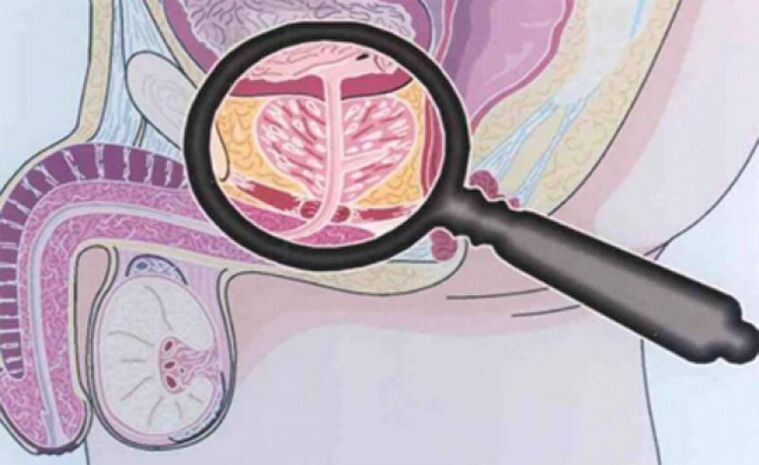
Disease complications
The long course of chronic prostatitis is complicated by the disorders of sexual and reproductive functions, the development of diseases such as vesiculite and epipidimitis, as well as the sclerosis of the organ.The spray of the organ worsens local microcirculation and urodynamics, as well as the results of surgical interventions.The fibrosis of the perihumetral tissues leads to the development of urinal disorders.
Diagnosis
Due to the fact that there are many reasons for the development of chronic prostatitis, a whole complex of diagnostic studies is used to diagnose it.The success of treatment depends on the correct determination of the causes of the disease.The diagnosis of chronic prostatitis is based on the following data:
- Classic triad of symptoms.
- A complex of physical methods (rectal examination of the prostate fingers).
- A complex of laboratory methods (urine analysis and microscopy of the prostate, sowing and determining the sensitivity of microflora to antibacterial drugs, general analysis of urine and blood).
- To detect gonococci, smear of urethra, PCR bacterioscopy and serological methods (to detect ureplasmas and chlamydia).
- Urofluometry.
- Prostate biopsy.
- A complex of instrumental methods (ultrasound).
- Determination of the patient's immune state.
- Determination of neurological status.
- With the inefficiency of treatment and suspicion of the development of complications, calculated and magnetic resonance images, blood planting, etc.
Palpation of the prostate gland
The palpation of the prostate, which increases during the period of exacerbation and decrease in the period of the subsidiary of the inflammatory process, is of the utmost importance in the diagnosis of the disease.In chronic prostatitis, during the Iron exacerbation period it is swollen and painful.
The density of the organ of the organ can be different: the softening and compaction areas are palpated, Western areas are determined.In palpation, it is possible to evaluate the shape of the gland, the condition of the seed tubers and the surrounding tissues.
The transrectal fingers exam process is combined with the seizure of the gland.Sometimes it is necessary to obtain a secret from each action separately.
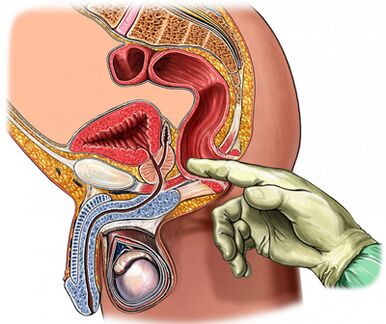
Analysis of 3 glass of urine and the secret of the prostate
The gold standard in the diagnosis of chronic prostatitis is:
- Collection of the first portion of urine.
- Collection of a second portion of urine.
- Obtaining the secret of the gland by massage.
- Collection of the third portion of urine.
Next, a microscopic and bacteriological examination of the material is carried out.
With inflammation of the prostate:
- The microbial number (CFU) exceeds 103/ml (104/ml for epidermal staphylococci), but should not be neglected by a small number of microbes calculated by dozens and hundreds.
- The presence of 10-15 leukocytes in the field of view detected by microscopy is a generally accepted criterion for the presence of an inflammatory process.
The secret of the prostate and the third portion of urine are subject to microscopic and bacteriological studies:
- In chronic bacterial prostatitis, an increase in the number of leukocytes in the secretion of the gland is observed and the third portion of urine after massage, bacteria (mainly intestinal group) is released.
- With non-bacterial prostatitis, an increase in the number of leukocytes in the secretion of the gland is observed, but the microflora is not detected.
- With CTB, there are no increased amounts of white blood cells and microflora.
The normal indicator of the prostate secret:
- Leukocytes less than 10 in the field of vision.
- Lecitin grains are a large number.
- There is no microflora.
In chronic prostatitis in the secretion of the prostate, there is:
- The number of leukocytes is very successful 10-15 in the field of view.
- The amount of lecithin grains is reduced.
- The pH of the secretion shifts towards the alkaline side.
- The acid phosphatase content is reduced.
- Smozyme activity increases.
Getting negative prostate secretion results once does not prove the lack of an inflammatory process.
The value of prostate secretion testing remains.Normally, during crystallization, a characteristic fern leaf-shaped pattern is formed.In case of violation of the aggregation properties of the prostate secret, such a pattern is not formed, which occurs with changes in the androgenic hormonal background.
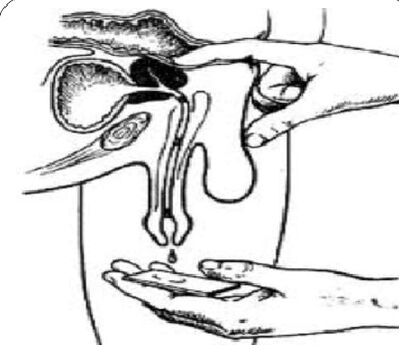
Ultrasound study
In case of suspicion of prostate disease, an ultrasound examination of the gland itself (transient ultrasound) is used, the kidneys and bladder are optimal, which allows you to determine:
- Volume and dimensions of the gland.
- The presence of calculations.
- The dimensions of the seed bubbles
- The condition of the walls of the bladder.
- The amount of residual urine.
- Clothing structures.
- Another type of pathology.
Other prostate research methods
- The state of urodynamics (study of urine flow) is determined easily and simply using a study such as uroflowetry.With the help of this study, it is possible to detect timely signs of infravizia obstruction and carry out dynamic observation.
- Punch biopsy is carried out in case of suspected abscess, benign hyperplasia and prostate cancer.
- To clarify the causes of the development of the infravezicular obstruction, a radiological and endoscopic examination is carried out.
- With a long and fluid inflammatory process, it is recommended to carry out urethrocystoscopy.
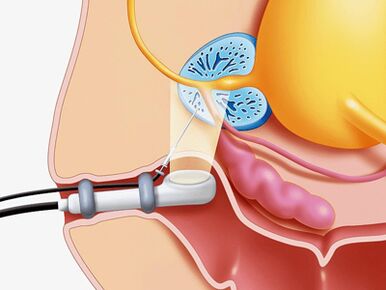
Differential diagnosis
Chronic prostatitis should be distinguished from vesiculoprostatostasis, vegetative prostatopathy, congestive prostatitis, pelvic floor myalgia, neuropsychiatric disorders, pseudodysynergia, reflex sympathetic dystrophy, inflammatory diseases of other organs: interstitial cystitis, osteitis of the symphysisof the pubis, sexual dysfunction, hypertrophy of the bladder neck, urethral stricture, tuberculosis, prostate and bladder cancer, urolithiasis, chronic epipidimitis, inguinal hernia.
Treatment of chronic prostatitis.
The treatment of chronic prostatitis should begin with changes in the lifestyle and patient's diet.
In the treatment of the disease, medications that affect different parts of pathogenesis are used simultaneously.
Main directions of therapy:
- Elimination of causative microorganisms.
- Anti-inflammatory therapy.
- Standardization of blood circulation in the prostate and pelvic organs.
- Standardization of proper drainage of prostate acinos.
- Normalization of the hormonal profile.
- Prevention of sclerosis of organs.
For the treatment of chronic prostatitis, the following groups of drugs are used:
- Antibacterial
- Anticholinergic.
- Vasodilators.
- Alpha1– adrenergic blockers.
- 5 alpha reductase inhibitors.
- Cytokine inhibitors.
- Non-steroidal anti-inflammatory.
- Angioprotectors.
- Immunomodulators.
- Preparations that affect the exchange of uratos.
Antibiotics in the treatment of chronic bacterial prostatitis
Antibacterial therapy must be carried out taking into account the sensitivity of microorganisms detected to antibiotics.In the case of non -detection of the pathogen, empirical antimicrobial treatment is used.
The drugs chosen are fluoroquinolones of generation II - IV.They quickly penetrate the tissues of the gland with ordinary methods of use, show activity against a large group of gram-negative microorganisms, as well as ureplasma and chlamydia.In case of failure of antimicrobial treatment, it should be assumed:
- Microflora Polyurezancy,
- Short treatment courses (less than 4 weeks),
- Incorrect selection of antibiotic and its dose,
- changes in the type of pathogen,
- The presence of bacteria living in the prostate ducts, covered with a protective extracellular membrane.
The duration of treatment should be at least 4 weeks with subsequent subsequent bacteriological control.In case of preservation in the third part of the urine and the prostate secret of bacteriuria more than 103The correspondence of a re -antibacterial therapy for a period of 2 to 4 weeks is prescribed.
Cytokine inhibitors in the treatment of chronic prostatitis
Cytokines are glycoproteins that are secreted by immune cells and others under conditions of inflammatory reaction and an immune response.They take an active part in the development of a chronic inflammatory process.
Non -steroidal anti -inflammatory drugs
Non -steroidal anti -inflammatory medications have an anti -inflammatory effect, reduce pain and fever.They are widely used in the treatment of chronic prostatitis in the form of tablets and suppositories.The most effective is the rectal path of the introduction.
Immunotherapy
In the treatment of chronic bacterial prostatitis, in addition to antibiotics and anti -inflammatory drugs, immunomodulating agents are used.The most effective is the rectal path of its introduction.The immunomodulator is widely used, which increases the functional activity of phagocytes, which contributes to a more effective pathogens.
ALFA BLOCATORS IN THE TREATMENT OF CHRONIC PROTETITITIS
It was established that alpha-1 adrenergic shoes normalize the tone of the smooth muscles of the prostatic part of the urethra, seed bubbles and prostate capsules, which makes drugs of this group very effective in the treatment of the disease.Alpha-1 adrenergic shoes are used in patients with pronounced urination disorders in the absence of an active inflammatory process.
With CTB, the treatment period is 1 to 6 months.
5A-Reductase inhibitor in the treatment of abacterial prostatitis and SDPC
It has been established that under the influence of the enzyme 5a-reductase, testosterone is converted into the prostate form 5a-dihydrotestosterone, the activity of which in prostate cells is more than 5 times higher than the activity of testosterone itself, which in older people leads to an enlargement of the organ due to epithelial and stromal components.
When an inhibitor of the 5A-Reductase is taken, stromal tissue atrophy is observed for 3 months, atrophy of the glandular tissue for 6 months, the secretory function is inhibited, the intensity of the pain and the volume of the gland is reduced, the tension and the swelling of the organ is reduced.
The role of antisclerotic drugs in the treatment of chronic prostatitis.
With prolonged inflammation of the prostate, fibrosis develops, which is manifested by disturbances in microcirculation and urodynamics.To prevent the fibrosis process, antisclerotic drugs are used.
Other drugs used in the treatment of chronic prostatitis.
Together with the medications described above, the following are used to treat the disease:
- Antihistamines.
- Vasodilators and angioprotectors.
- Immunosuppressants.
- Medications that affect the metabolism of the Urates and trisodic citric acid.
herbal products
Effective in the treatment of prostatitis is the use of a drug in the form of suppositories that contain a complex of biologically insulated biologically active peptides of the prostate gland of the cattle.
Under the influence of the drug occurs:
- Stimulation of metabolic processes in glandular tissues.
- Improvement of microcirculation.
- Reduce swelling, leukocyte infiltration, stagnation of secretions and pain.
- Prevention of thrombus formation in the prostate venules.
- Increased activity of the secretory epithelium of the acini.
- Improvement of sexual function (increased libido, restoration of erectile function and normalization of spermatogenesis).
Massage with the prostate fingers.
Several researchers maintain that, in case of chronic prostatitis, finger massage should be used, taking into account known contraindications.
Physiotherapy
The effectiveness of physiotherapeutic procedures in the treatment of prostatitis has not been tested to date, the mechanism of action is not scientifically established and adverse reactions have not been studied.
Prevention of chronic prostatitis.
When beginning to prevent the development of chronic prostatitis, you should know:
- The risk of developing the disease increases with age.
- Representatives of the black race are more predisposed to the disease.
- A family predisposition cannot be excluded to the disease.
People who are predisposed to the development of chronic prostatitis should pay more attention to their health.
Disease prevention tips:
- Drink a sufficient amount of liquid.Frequent urination promotes leaching of microflora from the urethra.
- Avoid diarrhea and constipation.
- Adhere to a rational diet.Do not eat saturated foods with carbohydrates and saturated fats, which leads to an increase in body weight.
- You should limit the use of substances that irritate the urethra: sharp and spicy dishes, smoked meats, sauces and seasonings, coffee and alcohol.
- Reject smoking.Nicotine negatively affects the condition of vascular walls.
- Don't overdo it.
- Do not hold the emptying of the bladder.
- Direct an active lifestyle, practice sports.Do the exercises to strengthen the pelvis muscles, which allows you to eliminate the stagnation of venous blood, which, in turn, supports the normal function of the prostate gland.
- Manage regular sexual life.Avoid prolonged abstinence.Iron must be released in a timely manner from the secret.
- Keep adherents of monogamous relationships.Illegal sexual relations increase the likelihood of acquiring sexually transmitted diseases.
- If the complaints appear by the genitourinary authorities, communicate immediately with a urologist.
